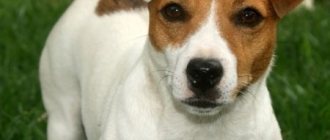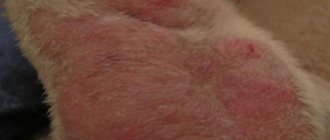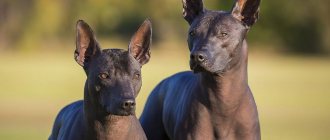Bathing
Starting from three weeks, a poodle puppy needs to be washed every 2 weeks. At this age, the coat has a silky texture and does not tangle. After 6 months it changes to long, downy, with hard and springy guard hairs. The use of specialized shampoo and conditioner is recommended.
Bathing should be done in warm water. Using hot water damages the hair structure and can cause premature shedding. It is necessary to thoroughly wet the wool and apply shampoo to the entire surface, lather and rinse well.
After this, conditioner balm is applied. Depending on the company, the exposure time with it ranges from 3 to 7 minutes. The conditioner nourishes, but at the same time weighs down the coat. It must be washed off without leaving any residue.
Next, excess moisture is squeezed out with your hands, and the remainder is removed with a rubberized napkin. After wrapping the poodle in a terry towel, wait about 5 minutes. After this, you can start drying.
Lightening is done either with a specialized compressor or with a high-power hair dryer. Simultaneously with knocking out moisture from the surface, it is necessary to use a special slicker comb to make combing movements with a pull.
Detergents
Chris Kristen sets are perfect for poodles (White-on-white - for white, black and harlequin color. And also Gold-on-gold - for apricot). These sets consist of four cosmetics: shampoo that saturates the original coat color, volume shampoo, conditioner and a special spray for quick drying.
“Crown Royal” and “Biogroom” also give good results on poodles. On apricot hair color, Biogrum's Bronze Luster shampoo gives elasticity and shimmering shine.
If it is not possible to purchase a special shampoo, you can use moisturizers intended for people outside of exhibitions. For example, Garnier shampoo for dry hair, or Belita.
What to do?
If a dog’s ears smell bad, then the most useful thing for the owner to do is to clean them with cotton swabs once a week, for dogs with short ears - more often, taking utmost care not to damage the eardrum and do an analysis of the ear flora.
If your ears are clean, there is no need to treat them! It is common to see dark brown, sticky wax in the ears, which is a natural defense against small debris and bacteria that cause inflammation. Getting rid of it is not difficult.
How to remove a slight odor? It is enough to clean your ears with a special lotion sold in a pharmacy, a solution of chlorhexidine, or saline solution (mix boiled water with a small amount of salt). You cannot clean your ears with hydrogen peroxide, because... You can irritate or even burn the delicate skin inside your ear canal!
To clean the ears of large dogs, it is better to use a cotton pad; for small dogs, it is better to use a cotton swab.
However, remember that wax itself protects the ear and even kills harmful bacteria! It is produced in the external auditory canal and, moving towards the auricle, absorbs dead skin cells, dust, and sebum.
A very important point: when cleaning, you cannot climb into the ear canal itself! This can only be done by a doctor using instruments designed for this purpose!
We can only clean the ear on our own, i.e. what's outside. There is sulfur there, which has already lost its beneficial properties and has become a favorable environment for the development of bacteria.
Do you need to scratch?
Uncombed fur becomes matted and spoils the appearance of the poodle; moreover, severe tangles cause pain and discomfort to the dog. Over the age of 6 months, it is necessary to brush the dog once every 2 weeks, at the same time the dog is washed. In this case, no additional actions are required.
Combs
The owner should have a variety of combs in his arsenal, including flat combs with rare and frequent metal teeth, a massage comb, slickers of various shapes and sizes.
So, narrow triangular-shaped slickers are suitable for decorating paws. And to form the mane and hair on the body, you need the widest possible options, with fine teeth. It is most convenient to choose models with rubberized handles and a cleaning function.
How to do it?
After the dog has formed an adult coat, combing is best done using special detangling sprays. This will shorten the process itself and make it more convenient.
It is necessary to comb before washing, as wet hair becomes even more tangled. It is best to start combing from those places where the hair is short. Namely from the croup and hips. Then move on to the sides, stomach, head and legs.
Why does my ear stink?
During the next cleaning of the dog’s ears, the responsible owner notices swelling, dirt, redness, smelly dark discharge from the ear or even a dense black coating; in especially advanced cases, pus flows and a sharp stench is felt, which indicates a disease.
At first, the dog occasionally scratches its ears, shakes its head and does not give in for affection, and later, when the moment of early detection of the disease is missed, the animal begins to experience severe pain and whine, in some cases even showing unusual aggression. Then the owners come to their senses and don’t know what to do.
So, why can your ears smell very unpleasant:
- Inadequate care.
- Cold water getting into ears.
- Walking in wooded areas where ticks may be present.
- Ignoring existing diseases.
- Insect or animal bites.
- Allergies - due to ingestion of plant pollen.
- Anatomical structure of the ears (standing short ears and hanging, long ears)
- Hematomas - ruptures, swelling after an impact.
- Bacteria and fungi (staphylococcus, streptococcus)
- Features of the breed.
For example, the German Shepherd synthesizes large amounts of sulfur, so a slight odor may occur. BUT: if your ears smell very strongly, then this is not normal, this should not happen in any case!
If your pet suddenly begins to perform the following actions, then you need to look for the causes of the disease and unpleasant stench in the ears:
- It scratches ears, sometimes until they bleed.
- Shakes his head.
- Loses orientation in space.
- Aggression towards affection.
- Decreased appetite.
- Apathy.
Internal symptoms:
- Purulent discharge.
- The ear is red and swollen inside, and at the same time it smells sharply and hurts.
- Neoplasms.
About haircuts
Regardless of whether the pet will attend exhibitions or not, it needs mandatory hygienic haircuts. This not only decorates the pet, but also makes his life complete, leaving his eyes, ears and anus open. Regularity is at least once a month. For this we need a machine and a nail clipper.
The poodle's muzzle is shaved with a machine, the back of the nose to the level of the eye line, then the hair under the eyes and on the cheekbones, chin and neck is removed in a semicircle. At the same stage, using a special powder, hairs are removed from the auricle.
It is necessary to shave the belly starting from the navel towards the genitals, around the anus and from the bottom of the base of the tail. After this, you can move on to shaving your paws. The fur is carefully trimmed from the side of the pads, and removed briefly in the areas between the toes and on the outside.
Overgrown claws are shortened with a nail clipper once every 2 weeks. The hygienic haircut ends here.
After the stage of bathing and hair drying, if necessary, they move on to a model haircut. The standard clearly defines the forms of haircuts allowed on poodles. The types allowed are “Lion”, “Modern”, “Pappy Clip”, “English Cut”, “Terrier”. For each of them, it is clearly regulated which parts will be shaved, where the hair remains and what length.
A separate chapter covers preparation for corded poodle shows.
This is not a separate breed, but a type of coat laying. Cords begin to form from an early age and throughout life. However, the short-shaven areas of these poodles are exactly the same as with the classic style.
What should it smell like?
A very unpleasant, sour odor from the ears of some breeds (Yorkies, Shih Tzus, poodles) may appear due to the presence of hair in the ears. Imagine, dirty hairs glued together with sulfur absorb all the dead cells and dirt that accidentally gets into the ear and impede the natural ventilation of the ear canal, which, of course, leads to inflammatory processes and a strong musty odor.
You'll have to learn to pluck hairs from your ear! The main thing is not to be afraid to hurt the dog: there are not many nerve endings on the surface of the skin in the auricle, and this procedure is more unpleasant than painful.
Mushrooms or fish
Ear mites are a common culprit of strange odors. It appears as a black plaque inside the ear on the surface of the auricle.
Fungi also give off a nasty fishy smell: pay attention to whether your pet is scratching its ears? All fungal infections begin with unbearable itching and redness of the ears. Fungal infections can be treated and generally identified only by a doctor! Do not believe what is written on the Internet and do not rely on your own experience: nothing can be more accurate than analysis!
If you spend time not treating with inappropriate drugs, you can lead to surgical excision of the external auditory canal!
If your ear is red inside, hurts and smells like a sweetish spoiled apple, then most likely your tail has otitis media - an inflammation characterized by severe redness, a bad odor and a sound similar to bursting bubbles inside the ear. The presence of pus indicates purulent otitis media, a more serious form of the disease.
To treat inflammation in the ears, Mastisan is most often prescribed, which should be used for 3 days (1 time) after cleaning the ear (preferably by a doctor). It is necessary to pour a small amount of the drug into the ear canal and massage the outside of the ear. As a rule, 3 days are enough for remission to occur.
Normally, a dog's ear wax is brown in small amounts, odorless, and the ear itself is pale pink, dry, and without damage.
Before starting treatment, consult a veterinarian, who will prescribe suitable means of combating diseases. Never self-medicate or use medications that are made for people.
Mushrooms or fish
Owner reviews
“When we got four-month-old Molly, a small apricot poodle, we had no idea how to cut her hair. There was an agreement with the breeder that we would bring her once every 2 weeks, at a time convenient for her, and wait until she was groomed. This was extremely inconvenient for us, since we had to constantly take time off from work.
As a result, I took matters into my own hands, and after several unsuccessful attempts I learned how to tidy up the wool quite well. Of course, I wouldn’t risk cooking like that for an exhibition; for a home haircut, such skills are more than enough.”
Larisa Ivanova, owner of the small poodle breed.
“I was recommended to wash my dog no more than once every three months, but then a disgusting dog smell appeared. Since our poodle sleeps with us and generally loves to cuddle, this schedule was unacceptable to us. We started washing it once every 3-4 weeks – the unpleasant smell disappeared!
I use human shampoos and conditioners, and every other time I make a mask with deep hydration. I’m happy with the result, the fur is shiny!”
Olga Makarova, toy poodle.
Composition of a veterinary first aid kit for a poodle
To provide first aid to a dog, you must have a veterinary first aid kit at home with a set of medications, dressings and instruments.
To do this, they usually use a small plywood or plastic box, which is mounted on the wall near the dog’s place. The first aid kit must be locked so that the dog does not have access to it, otherwise it may cause poisoning. The following essential items are stored in a veterinary home first aid kit:
- veterinary or medical thermometer,
- tweezers,
- syringe,
- eye pipettes,
- rubber hemostatic tourniquet,
- bandage,
- cotton wool;
disinfectants –
- 5-10% iodine solution,
- brilliant green,
- potassium permanganate,
- boric acid,
- Vaseline for processing the thermometer,
- streptocide,
- chloramine;
- antibiotics – penicillin, tetracycline;
- cardiac - caffeine, valerian drops;
- remedies used for poisoning - charcoal, Glauber's salt, xtor oil;
- antispasmodics and painkillers – piperazine, no-spa; astringents; anthelmintics; aerosol against insects.
If the owner wishes, the first aid kit can be replenished with other drugs.
Did you like it? Share with your friends!
How to care?
It is best to care for a poodle's ears using tweezers that have grooved ends. You should wrap the hairs in your ear around tweezers and pull them out with a sharp movement. Some experts recommend cutting such hairs rather than pulling them out, but this is an erroneous point of view.
The fact is that when trimmed, hair growth will constantly increase. But regular plucking leads to the fact that hair growth gradually begins to slow down, and the procedure itself becomes less and less unpleasant and painful. It is necessary to accustom your puppy to such care from the very first months.
After finishing the hair plucking procedure, you need to treat the ear with cotton wool. You need to clean your pet's ear using a stick with cotton wool wrapped around it. To do this, you need to use a special ointment: it can be calendula ointment or syntomycin emulsion. The ointment must be carefully applied to the poodle's ears so that it gets into all the folds. After treatment, the ears should be wiped dry.
Natural care
The sun's warmth is very beneficial for the animal's ears. You need to take your pet on your lap and turn his ear so that the sun's rays fall on it. The duration of the procedure should be five minutes for each ear. However, this beneficial procedure is not recommended in case of certain diseases.
At risk are breeds with long floppy ears (dachshund, poodle, spaniel, basset hound, some terriers and more). But from time to time other dogs also suffer from ear sores accompanied by redness of the ear.
Redness is often accompanied by itching, pain and accumulation of fluid with an unpleasant odor. The animal shakes its head until it bleeds, loses appetite, sleeps poorly (wanders from place to place). Sometimes your pet's temperature rises. The doctor will tell you what exactly caused the redness of the inner surface of the ear, and the owner’s task is not to delay visiting the veterinary center.
Allergy
Any substance (more often a food ingredient) can act as a provocateur; after it enters the body, the ear turns red, the skin flakes and becomes covered with pimples, and severe itching begins. In severe cases, purulent yellowish-gray discharge appears.
Unnoticed allergic otitis media is often complicated by a secondary infection (fungal or bacterial). In this case, the epidermis of the external auditory canal not only turns red, but also thickens (in chronic forms of the disease), and a high concentration of sulfur is observed. If neglected and complicated by infection, otitis media can lead to complete loss of hearing; moreover, a chronic disease is less easily treated and causes noticeable discomfort to the dog.
- demodicosis;
- otodectosis;
- cheyletiellosis.
Foreign body
As a rule, it gets into the ear canal of dogs (especially hunting ones), which often walk in forested areas. A limited area of redness will indicate that a foreign body, for example, a seed or a blade of grass, has entered the ear. In this case, you can do it yourself - remove the irritant from the dog's ear.
Other aspects
If your dog's ears itch and he shakes his head, you should be concerned, because this is a sure sign of ear disease. There are several of the most popular types of ear diseases in dogs: hematoma, eczema, etc. All these diseases are not local; a small hematoma can lead to serious inflammation, so it is necessary to respond in a timely manner to the dog’s unusual behavior.
Most often, dogs with long, floppy ears (retrievers), dogs with heavily overgrown ear canals (poodles), as well as puppies of all breeds are susceptible to inflammation in the ears.
We invite you to familiarize yourself with: Dogo Argentino breed description, character traits, maintenance and care











